oboe
All scores that include a part for at least one oboe.
- 1
- 2
Bach - Prelude & Fugue - Wind Quintet
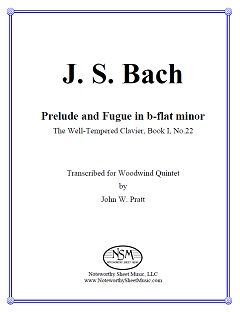 Prelude and Fugue, WTC Book I, No.22, by J.S.Bach
Prelude and Fugue, WTC Book I, No.22, by J.S.Bach
Transcribed for Woodwind Quintet by John W. Pratt, PDF $16.00
Score, 6 pages; Parts, 2 pages each for Flute, Oboe (plus alternate Alto Flute), Clarinet, Horn, and Bassoon; Total, 20 pages.
PreviewBach - Prelude and Fugue, BWV 532 - arr. Woodwind Quartet
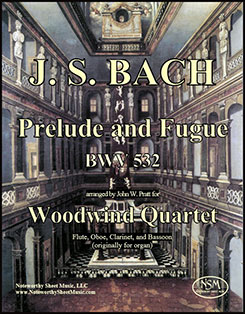 Prelude and Fugue, BWV 532, by J. S. Bach
Prelude and Fugue, BWV 532, by J. S. Bach
Arranged for Woodwind Quartet by John W. Pratt
Score and Parts, PDF $15.97
Click to listen to computer-generated audio samples from the score; audio clips from the Prelude (m4-22) and the Fugue (m14-27), are separated by a brief pause.
Score, 16 pages; Flute part, 5 pages; Oboe part, 6 pages; Bb Clarinet part, 6 pages; Bassoon part, 5 pages;Total, 46 pages.
PreviewBach - Toccata, Adagio, and Fugue - Wind Quartet
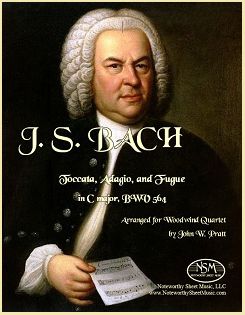 Toccata, Adagio, and Fugue in C major, BWV 564, by J. S. Bach
Toccata, Adagio, and Fugue in C major, BWV 564, by J. S. Bach
Arranged for Woodwind Quartet by John W. Pratt
Score and Parts for Flute, Oboe, Clarinet, & Bassoon, PDF $21.25
excerpted from JWP’s © foreword to the edition:
Among J. S. Bach's big organ works, the Toccata, Adagio, and Fugue, BWV 564 is atypical in ways that make it unusually well suited to transcription for woodwind quartet. Unlike most, it has a middle movement, an Adagio with an elaborate and gorgeous melody which lies comfortably for flute and can benefit greatly from the shaded, nuanced dynamics and articulations that a solo flutist can provide. The other winds bring out Bach's beautiful voice-leading in the Adagio's two inner parts and its marching but not martial bass. The four-part Fugue is unusual, too—light and lighthearted, happily adaptable to woodwinds, with no call for great power and, rather than a climactic ending, a fading coda that defies convincing treatment on the organ. The exuberant Toccata starts with an extended manual solo passage ... mostly in 32nd notes, which ... I felt it would be more effective as a game of frequent handoffs between instruments than as a series of longer individual études. The pedal solo, mostly 16ths, calls for the extra weight of doubling.
Click to listen to a computer-generated audio sample from the end of the Toccata into the beginning of the Adagio.
Score, 17 pages; Flute part, 6 pages; Oboe part, 5 pages; Bb Clarinet part, 5 pages; Bassoon part, 4 pages; Total, 46 pages.
PreviewBartók - For Children - arr. for Winds
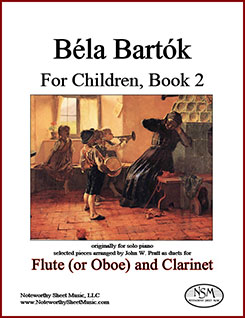 For Children, by Béla Bartók
For Children, by Béla Bartók
piano pieces based on Hungarian and Slovakian folksongs
Selected pieces arranged as woodwind duos, trios, or quartets by John W. Pratt and presented in multiple editions, organized by instrumentation and nationality.
Béla Bartók was not only a major composer in a post-Romantic extended tonal style, but he was also a superb pianist with a precise technique, a scholarly explorer of folk music, and a serious pedagog. Folk melodies and harmonies strongly influenced his music, both indirectly and often directly, including many of his orchestral and chamber works, as well as solo piano pieces ranging in difficulty from easy to virtuosic. His For Children (Gyermekeknek, 1908-1909, Sz. 42) was written for solo piano, and the original Books 1 and 2 contained 42 pieces after Hungarian folksongs and 43 pieces after Slovakian folksongs, respectively. Besides the usual purposes of music written for children, Bartók sought to broaden their musical experience with, for instance, modal and other scales, and harmonies outside the traditional western canon. For Children is by no means pablum; though the notes may be easy to play, these pieces have a lot else to offer. They were written when Bartók’s folksong research was well under way and his notational efforts at their peak. Students, teachers, and every-day players can make as much of them as they like ... as simple tunes for beginners content to learn basic notes and rhythms, or as more advanced studies on articulation, musicality, etc. —extracted from the preface by JWP
John Pratt has arranged selected pieces from the For Children books as various duos, trios, and quartets for wind instruments. As presented originally by Bartók, many of the folksongs are entirely or mostly in two voices, like Bach’s two-part inventions in style if not structure or harmony, and thus convenient for wind duo and no more childish for Bartók than Bach. Many others are also adaptable to duos of flute or oboe and clarinet or bassoon, mostly by spreading the left-hand chords in time. Still others of the For Children pieces are more suitable for a wind trio of flute (or oboe), B-flat clarinet, and bassoon, or a quartet of flute, oboe, B-flat clarinet, and bassoon. To compare the specific songs included in our editions with the complete set arranged for piano available in Bartók’s publications, visit the For Children listing on imslp.org.
All of the NSM editions described below are available as downloadable PDFs. We provide scores, but not separate parts, as all players can easily play off copies of the scores, which are organized for convenient page turns when the PDFs are printed two-sided in their entirety. Click the Preview button to view a page of the score from each edition. To order, in the table at the bottom of this webpage, check the box for the edition you would like to purchase, click Add to Cart, then click Checkout.
► Bartók - For Children, Book 1 - selected pieces arr. as Duets for Flute (or Oboe) and Clarinet 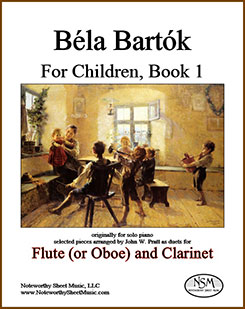 This edition includes 25 pieces from Book 1 arranged as duets; all of them can be played by B-flat clarinet and either flute or oboe, but for six of the pieces we also include alternative versions with octave changes that are better suited to oboe. The pieces included are Nos. 1-15, 22-26, 29, 31, 21, 40, and 42. Click to listen to computer-generated audio samples from the score; audio clips of #11 "Me and the Rain" with flute and clarinet and #32 "Wedding Day and Night" with oboe and clarinet are separated by a brief pause.
This edition includes 25 pieces from Book 1 arranged as duets; all of them can be played by B-flat clarinet and either flute or oboe, but for six of the pieces we also include alternative versions with octave changes that are better suited to oboe. The pieces included are Nos. 1-15, 22-26, 29, 31, 21, 40, and 42. Click to listen to computer-generated audio samples from the score; audio clips of #11 "Me and the Rain" with flute and clarinet and #32 "Wedding Day and Night" with oboe and clarinet are separated by a brief pause.
Score, 26 pages; Total, 30 pages.
Preview: Book 1, Flute (or Oboe) and Clarinet
► Bartók - For Children, Book 1 - selected pieces arr. as Duets for Oboe (or Flute) and Bassoon
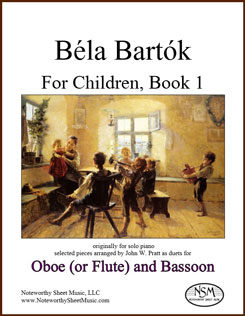 Our oboe (or flute) and bassoon edition includes the same 25 pieces from Book 1 as our flute and clarinet edition described above, except here they are arranged and optimized as duets for oboe and bassoon, with alternative versions better suited for flute and bassoon provided for two of the folksongs.
Our oboe (or flute) and bassoon edition includes the same 25 pieces from Book 1 as our flute and clarinet edition described above, except here they are arranged and optimized as duets for oboe and bassoon, with alternative versions better suited for flute and bassoon provided for two of the folksongs.
Preview: Book 1, Oboe (or Flute) and Bassoon
► Bartók - For Children, Book 2 - selected pieces arr. as Duets for Flute (or Oboe) and Clarinet

Our Book 2 edition of arrangements for flute (or oboe) and clarinet duo includes 23 pieces: Nos. 1-6, 8, 10-13, 16-20, 22, 25, 26, 29, 31, 35, and 36. All of these pieces can be played by B-flat clarinet and either flute or oboe, but we also include alternative versions that are more suitable for oboe for three of the pieces.
Score, 17 pages; Total, 22 pages.Preview: Book 2, Flute (or Oboe) and Clarinet
► Bartók - For Children, Book 2 - selected pieces arranged as Duets for Oboe (or Flute) and Bassoon
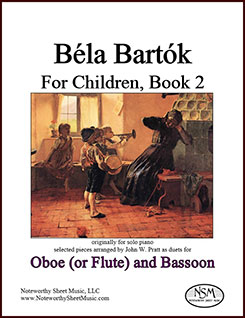 The oboe (or flute) and bassoon edition includes the same 23 pieces from Book 2 described above for flute and clarinet, here arranged and optimized as duets for oboe and bassoon, with an alternative version better suited for flute for one of the pieces.
The oboe (or flute) and bassoon edition includes the same 23 pieces from Book 2 described above for flute and clarinet, here arranged and optimized as duets for oboe and bassoon, with an alternative version better suited for flute for one of the pieces.
Preview: Book 2, Oboe (or Flute) and Bassoon
► Bartók - For Children, Book 1 - selected pieces arranged as Trios for Flute (or Oboe), Clarinet, and Bassoon
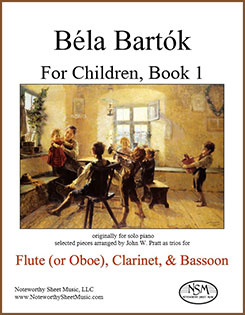 In this trio edition, we present 20 songs from Book 1, including 14 that are also available as duo arrangements in the editions listed above and 6 that are only offered in our trio edition. The pieces are Nos. 1-9, 11, 13-15, 19, 20, 30, 35, 39, 41, and 42. The trios are arranged for flute or oboe, B-flat clarinet, and bassoon. Click to listen to a computer-generated audio sample from #39 "Insect Wedding".
In this trio edition, we present 20 songs from Book 1, including 14 that are also available as duo arrangements in the editions listed above and 6 that are only offered in our trio edition. The pieces are Nos. 1-9, 11, 13-15, 19, 20, 30, 35, 39, 41, and 42. The trios are arranged for flute or oboe, B-flat clarinet, and bassoon. Click to listen to a computer-generated audio sample from #39 "Insect Wedding".
Score, 21 pages; Total, 24 pages.
Preview: Book 1, Flute (or Oboe), Clarinet, and Bassoon Trio
► Bartók - For Children, Book 2 - selected pieces arranged as Trios for Flute (or Oboe), Clarinet, and Bassoon
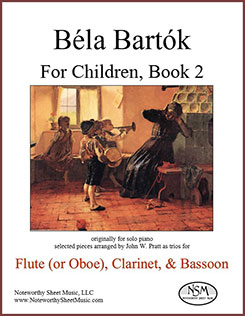 Here Mr. Pratt offers eighteen of Bartók’s Book 2 Slovakian folksongs in arrangements for a woodwind trio of flute or oboe, B-flat clarinet, and bassoon; the pieces included are Nos. 2, 3, 7, 9, 11-14, 16, 17, 21, 25, 26, 28, 29, 32, 33, and 42. Ten of these songs are also included in our duo arrangement publications.
Here Mr. Pratt offers eighteen of Bartók’s Book 2 Slovakian folksongs in arrangements for a woodwind trio of flute or oboe, B-flat clarinet, and bassoon; the pieces included are Nos. 2, 3, 7, 9, 11-14, 16, 17, 21, 25, 26, 28, 29, 32, 33, and 42. Ten of these songs are also included in our duo arrangement publications.
Preview: Book 2 Flute (or Oboe), Clarinet, and Bassoon Trio
► Bartók - For Children, Book 1 - selected pieces arranged for Wind Quartet (Flute, Oboe, Clarinet, and Bassoon)
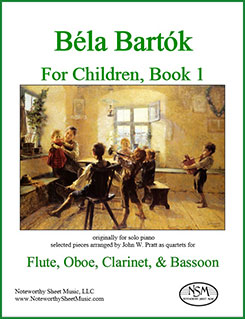 This edition includes eleven of Bartók’s Hungarian folksongs in arrangements for a woodwind quartet of flute, oboe, B-flat clarinet, and bassoon. Two of these songs, Nos. 19 and 20, are also included in our trio arrangement publication, but none are replicated in the duo arrangement editions; the quartet publication includes Book 1 Nos. 16-21, 27, 28, and 36-38.
This edition includes eleven of Bartók’s Hungarian folksongs in arrangements for a woodwind quartet of flute, oboe, B-flat clarinet, and bassoon. Two of these songs, Nos. 19 and 20, are also included in our trio arrangement publication, but none are replicated in the duo arrangement editions; the quartet publication includes Book 1 Nos. 16-21, 27, 28, and 36-38.
Score, 11 pages; Total, 14 pages.
Preview: Book 1, Flute, Oboe, Clarinet, and Bassoon Quartet
► Bartók - For Children, Book 2 - selected pieces arranged for Wind Quartet (Flute, Oboe, Clarinet, and Bassoon)
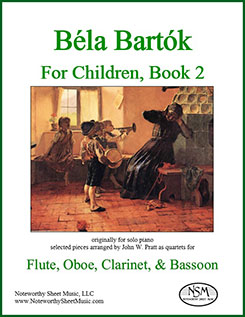 This edition presents seventeen of Bartók’s Book 2 Slovakian folksongs in arrangements for woodwind quartet (flute, oboe, B-flat clarinet, and bassoon). Four of these songs, Nos. 11, 14, 25 and 28, are also included in our trio arrangement publication, and several are included in the duo arrangement editions. The Book 2 songs arranged here as quartets are Nos. 5, 8, 11, 14, 15, 18, 23- 25, 27, 28, 30, 31, 34, 37, 38, and 43. Click to listen to a computer-generated audio sample that consists of ~32” of song #5 Bird in Flight (Theme & part of Var.1, through m34), followed immediately by #18 Former Flame in its entirety.
This edition presents seventeen of Bartók’s Book 2 Slovakian folksongs in arrangements for woodwind quartet (flute, oboe, B-flat clarinet, and bassoon). Four of these songs, Nos. 11, 14, 25 and 28, are also included in our trio arrangement publication, and several are included in the duo arrangement editions. The Book 2 songs arranged here as quartets are Nos. 5, 8, 11, 14, 15, 18, 23- 25, 27, 28, 30, 31, 34, 37, 38, and 43. Click to listen to a computer-generated audio sample that consists of ~32” of song #5 Bird in Flight (Theme & part of Var.1, through m34), followed immediately by #18 Former Flame in its entirety.
Preview: Book 2, Flute, Oboe, Clarinet, and Bassoon Quartet
Brahms - Drei Duette - 2 Voices and/or Instruments and Piano
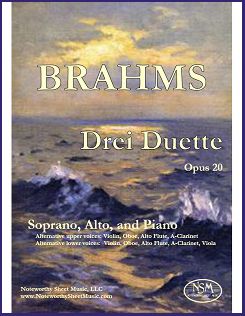 Drei Duette, Op.20, by Johannes Brahms
Drei Duette, Op.20, by Johannes Brahms
Transcribed for Mixed Voice, Instruments, and Piano by John W. Pratt
Score for Soprano, Alto, and Piano; Transcribed upper voice Parts for Violin/Oboe, Alto Flute, and A-Clarinet; and Transcribed lower voice Parts for Violin/Oboe, Alto Flute, A-Clarinet, and Viola; PDF $12.99
Composed in 1858–1860, the Drei Duette, Op. 20, for soprano and alto are the earliest of Johannes Brahms' duets and quartets for solo voices and piano. The three songs are titled Weg der Liebe (1. Teil), Weg der Liebe (2.Teil), and Die Meere. Except for brief canonic passages in No. 1, the voices have the same words, sung simultaneously, mostly in parallel thirds and sixths. The accompaniments are straightforward, without Brahmsian ensemble challenges but not without harmonic interest. Many have found the songs Mendelssohnian. The words come from the collection Stimmen der Völker of Johann Gottfried Herder (1744–1803). The first two are translations by Herder of two parts of a Northern English folk poem Love will find out the Way. The third is Italian in origin.
The vocal parts lie well for many instruments, opening the possibility of mixed voice and instrument, as well as fully-instrumental, performances. If one voice is replaced by an instrument, no words will be lost and the result will be a song with wonderful instrumental obbligato and piano accompaniment. If two instruments are used, the result is a beautiful "song without words." We include in our edition transcriptions of both voices for oboe/violin, alto flute in G, and clarinet in A, and of the lower voice for viola as well. Our transcriptions provide slurs to suggest a vocal style to instrumental players and to facilitate coordination of the instrumental parts with those of the voices. We also provide a re-notated piano/vocal score, in which repeat signs are used in the second and third songs to save page turns, rather than writing out the multiple stanzas as in the original. For those needing only the piano/vocal score, the Breitkopf & Härtel edition is in the public domain and freely available on imslp.org.
Piano/Vocal Score, 10 pages; Instrumental Parts, 3 pages each; Total, 42 pages.
PreviewBrahms – Variationen über ein Thema von Robert Schumann – Pf, Fl, Ob, Cl, Bn
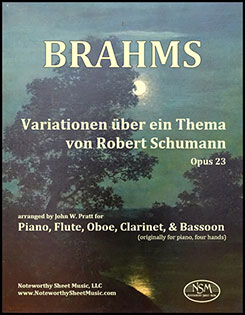 Variationen über ein Thema von Robert Schumann, Op.23, by Johannes Brahms
Variationen über ein Thema von Robert Schumann, Op.23, by Johannes Brahms
Arranged for Piano, Flute, Oboe, Clarinet, and Bassoon by John W. Pratt
Piano Score and Wind Parts, PDF $16.99
- adapted from John W. Pratt’s foreword to the edition: Brahms’s Variations on a Theme by Robert Schumann, Op.23, were written in tribute to his friend, for piano four hands. Yet how often have you heard this exquisite masterpiece, in any form? Arranging it as a quintet for piano and winds allows realization of its implicit orchestral effects and incorporation of contrasting and beautiful woodwind sonorities while preserving its many special piano sonorities and its personal, chamber music qualities and will, hopefully, encourage performance. The variations range from delicately decorative (Var. I) to spectral (IV) to warmly Brahmsian (many) to bravura (IX) and even perhaps witty (V and VII). The final variation (X) is an amazing valedictory, a funeral march which becomes combined with the theme and is suffused throughout with sadness, solemnity, resignation, and reaffirmation, by turns and even simultaneously. Especially apt contributions by the woodwinds in this arrangement include, to mention just two, the appreciative chuckles accompanying the rollicking theme of Var. V and the chorale effect at the end of Var. X. At the same time, the arrangement allows the piano to fulfill its usual roles in chamber ensembles and to contribute some special colorings of its own, including the multi-octave filigree of Var. I, the layout of the accompaniments in the first part of Var. III and last part of Var. V, the bass rumbles of Var. IV and Var. X, and the two-hand octaves in Var. VI and Var. IX.
Listen to a computer-generated audio clip of the Theme; of course, real live instruments will sound even better:
The Preview below is a page of the score from Var. VI. Note that the score is presented in concert pitch.
Score, 28 pages; Flute, Oboe, B-flat Clarinet, and Bassoon parts, 4 pages each; Total, 48 pages.
PreviewCoste - Les Regrets - Afl or Fl (or Ob, Vn) and Pf (or Guitar, Harp)
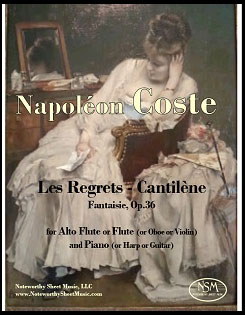 Les Regrets-Cantilène, Op.36, by Napoléon Coste
Les Regrets-Cantilène, Op.36, by Napoléon Coste
Transcribed for Alto Flute or Flute (or Oboe or Violin) and Piano (or Harp or Guitar) by C.A.Vater
Score, Alto Flute Part, and alternative Flute (or Oboe or Violin) Part, PDF $5.99
Napoléon Coste (1805-1883) became famous not only as a guitar soloist, but also as a major composer of some 60 works, most of which were written for guitar. His music is in the romantic French style and appreciated for its originality. His Fantaisie, Op.36, Les Regrets-Cantilène, is a short, single-movement piece written for oboe or violin with piano or harp or guitar. We created our Noteworthy Sheet Music edition from the difficult-to-read manuscript version in the public domain, available on imslp.org. We include a score in concert pitch and a part suitable for flute, oboe or violin, as well as a part transcribed for alto flute in G. The piece falls nicely within the sweet range of the alto flute and our transposition sounds appealing and completely natural on that instrument. In fact, Les Regrets-Cantilène is gorgeous on either flute or alto flute. Melodic and sentimental, the work is not overly demanding technically and should appeal to players of a moderate or higher skill level.
Score, 4 pages; Alto Flute part, 1 page; Flute (or Oboe or Violin) part, 1 page; Total 8 pages.
PreviewFigueiredo - Na Rua Dos Meus Ciúmes - WW5
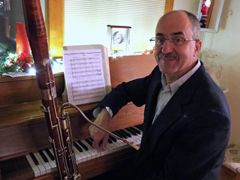 Na Rua dos Meus Ciúmes, Traditional Fado
Na Rua dos Meus Ciúmes, Traditional Fado
Arranged for Woodwind Quintet by Antonio F. Figueiredo
Parts and Score, PDF $10.00
Na Rua Dos Meus Ciúmes is a traditional Portugese fado, still highly popular among recording artists today. This passionate love song tells the story of the intense jealousy experienced by a girl upon seeing her lover pass by with another woman on the street near her home. Though her pain is palpable, the girl is proud and determined to endure her suffering resolutely and without tears.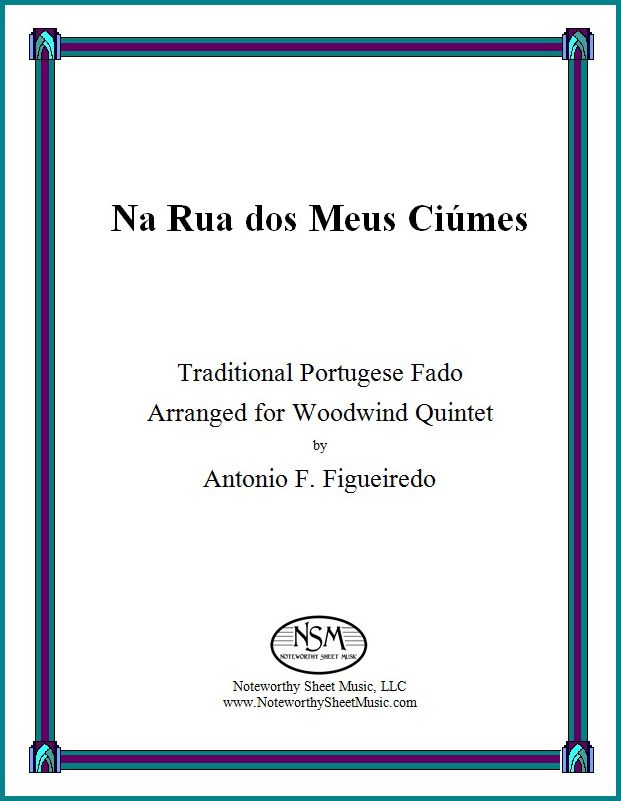
Antonio Figueiredo was born in the Azores, Portugal, and now resides in Massachusetts. He grew up listening to (and falling in love with) fado music, with all its romance and passion, and its timeless themes of love, loss, jealousy, poverty, and the sea. Figueiredo is a bassoonist who plays regularly in various orchestras and chamber music groups in the Boston area. He enjoys arranging folk tunes for woodwind quintet, and he created this delightful and engaging arrangement of Na Rua Dos Meus Ciúmes for one of his own groups. The piece is scored for flute, oboe, clarinet in B-flat, horn in F, and bassoon.
"This brief piece is a charming addition to the quintet repertory." Read John Ranck's full review of Figueiredo's arrangement of Na Rua Dos Meus Ciúmes.
Score, 5 pages; Parts, 1 page each; Total, 12 pages.
PreviewHaydn - Early Sonatas - arr. as Wind Duos
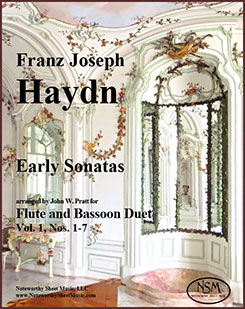 Early Sonatas, by Franz Joseph Haydn
Early Sonatas, by Franz Joseph Haydn
Arranged as Woodwind Duets by John W. Pratt (originally for keyboard)
Even the earliest of Franz Joseph Haydn’s keyboard sonatas have great rhythmic variety and vitality, and are delightful when played with verve. They are mostly in two voices, and even where not, their early classical harmonies are easily conveyed by two instruments. They incorporate few pianistic effects and lie comfortably within range for flute or oboe and bassoon or clarinet, and thus make natural woodwind duets of lively, interesting music. All these editions include a score and parts. Those wishing to consult the keyboard editions of the Haydn sonatas, from which Mr. Pratt created his arrangements, can find them at imslp.org. (Adapted from J. W. Pratt’s preface to the edition.)
Cover image “Decorations of the Sala Terrena, Eszterházy Palace in Fertőd, Hungary“ by Monyesz, Creative Commons Attribution-Share Alike 3.0 Unported license.
--------------------------------------------------------------------------------
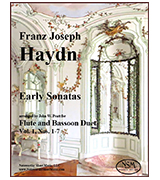 This edition includes seven of Haydn's early keyboard sonatas arranged as duets for flute and bassoon. John Pratt's creation of these duets was inspired by a desire to offer two of his music colleagues some new music to enjoy, as they had exhausted their available flute and bassoon duo repertoire. These duets work nicely for winds and are fun to play. For a sense of how they sound when played by flute and bassoon, click below to listen to a computer-generated audio excerpt: the first 45” of the recording come from the Andante of Sonata 5 (Hob. XVI:11), followed by 25” of the Sonata 6 (Hob. XVI:10) Presto. Alternatively, the flute part can be played on oboe, making these sonata arrangements nicely amenable to oboe and bassoon duos as well.
This edition includes seven of Haydn's early keyboard sonatas arranged as duets for flute and bassoon. John Pratt's creation of these duets was inspired by a desire to offer two of his music colleagues some new music to enjoy, as they had exhausted their available flute and bassoon duo repertoire. These duets work nicely for winds and are fun to play. For a sense of how they sound when played by flute and bassoon, click below to listen to a computer-generated audio excerpt: the first 45” of the recording come from the Andante of Sonata 5 (Hob. XVI:11), followed by 25” of the Sonata 6 (Hob. XVI:10) Presto. Alternatively, the flute part can be played on oboe, making these sonata arrangements nicely amenable to oboe and bassoon duos as well.Preview: Vol.1, Nos. 1-7, Flute and Bassoon
--------------------------------------------------------------------------------
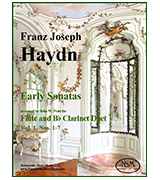 ►Early Haydn Sonatas arranged by John W. Pratt as Duets for Flute and B-flat Clarinet, Vol. 1, Nos. 1-7
►Early Haydn Sonatas arranged by John W. Pratt as Duets for Flute and B-flat Clarinet, Vol. 1, Nos. 1-7
Preview: Vol.1, Nos. 1-7, Flute and Clarinet
Haydn - Trio, Hob. XV:18 - arr. Woodwind Quartet
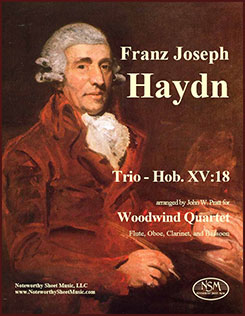 Trio, Hob. XV:18, by Franz Joseph Haydn
Trio, Hob. XV:18, by Franz Joseph Haydn
transposed to B-flat major and arranged for Woodwind Quartet by John W. Pratt
Score and Parts for Flute, Oboe, B-flat Clarinet, and Bassoon; PDF $20.97
As noted in the arranger’s forward to the edition, the later piano trios of Franz Joseph Haydn (1732-1809) are superb music, but because they were written for excellent pianists and weak string players, they are dominated by the piano part. This imbalance among the parts actually makes the trios highly amenable to and effective in arrangement for woodwind quartet. Written after Haydn’s first visit to London, the Piano Trio in A major, Hob. XV:18, was first published in 1794. The first of its three movements, a flowing Allegro moderato, is unified by ingenious use of the three-note motif opening its cantabile main theme. The lovely middle Andante, in ABA form and 6/8 meter, features some luxurious ornamentation and proceeds attacca to the spirited and humorous Allegro finale. The resources of a woodwind quartet are well suited to the musical ideas of this trio, and the arrangement adapts Haydn’s piano, violin, and cello lines wonderfully to the range and sonority of the instruments used: flute, oboe, B-flat clarinet, and bassoon. This adaptation is facilitated by transposition from Haydn’s original key of A major to B-flat major. We provide parts plus a score in concert pitch.
Click to listen to computer-generated audio samples from the score; audio clips from movements I (m44.4 - m64.3), II (m0 - m4.5 & m49.6 - m54.5), and III (m36.2.2 - m48) are separated by brief pauses.
Score in concert pitch, 21 pages; Flute part, 8 pages; Oboe part, 6 pages; B♭-Clarinet part, 5 pages; Bassoon part, 5 pages; Total, 52 pages.
Preview- 1
- 2
